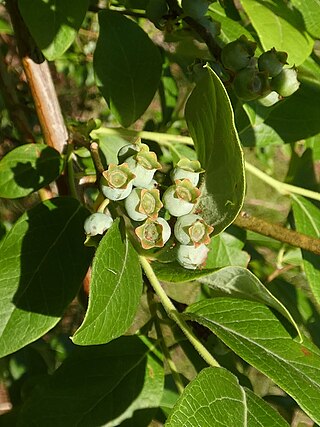Vaccinium formosum
Species of plant From Wikipedia, the free encyclopedia
Vaccinium formosum, with common names highbush blueberry, southern blueberry, southern highbush blueberry, and swamp highbush blueberry, is a species of blueberry native to the Southeastern United States.
| Vaccinium formosum | |
|---|---|
 | |
| Scientific classification | |
| Kingdom: | Plantae |
| Clade: | Tracheophytes |
| Clade: | Angiosperms |
| Clade: | Eudicots |
| Clade: | Asterids |
| Order: | Ericales |
| Family: | Ericaceae |
| Genus: | Vaccinium |
| Section: | Vaccinium sect. Cyanococcus |
| Species: | V. formosum |
| Binomial name | |
| Vaccinium formosum Andrews | |
Description
Vaccinium formosum is a deciduous shrub that grows to approximately 4–4.5 metres (13–15 ft) tall.[1][2] The plant has green stems that turn into woody growth as the stems age.[2] The leaves are ovaloid, green, and about 2.5–7.5 centimetres (1–3 in) long.[2]
The flowers are whitish-pink and bell-shaped. The fruit is a dark blue berry with a glaucous bloom on one end.[2]
Distribution and habitat
Vaccinium formosum is native to the Southeastern United States. It has been found in Alabama, Florida, Georgia, South Carolina, North Carolina, Virginia, Washington, D.C., Maryland, Delaware, and New York.[3][4] It grows in a variety of habitats including bogs, pine barrens, mires, ravines and mountain summits.[4]
Cultivation
The plant's primary habitats are in marshes, wetlands, and loamy/sandy soils.[5] It prefers low pH, acidic soils and will not fruit or grow well in basic conditions. The ideal conditions for this plant are in full sun; it can handle partial-sun though it may fruit less.[2] The harvest season of the edible fruit of the Vaccinium formosum is primarily late spring/summer.[2]
Uses
The berries are edible in both raw and cooked forms.[citation needed]
Further reading
- Wiersema, J. H., León, B. (1999). World Economic Plants: A Standard Reference. United States: CRC-Press. ISBN 9780849321191, 0849321190
- Hancock, J. F., Retamales, J. B. (2018). Blueberries. United Kingdom: CABI. ISBN 9781780647265, 1780647263
References
Wikiwand - on
Seamless Wikipedia browsing. On steroids.
